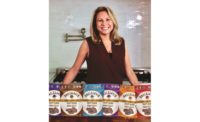Snack Food & Wholesale Bakery recently was able to talk to Emily Hallock, primary research manager, Glanbia Nutritionals, Chicago, about snack and bakery "MegaTrends" for 2020 and the next few years.
Liz Parker: What snack and bakery MegaTrends do you predict for 2020 and the coming years?
Emily Hallock: In the immediate future (and now) we’re seeing an increase in consumer interest of baking at home. Baked goods and bread are two of the top products consumers are making at home during this time of stay-at-home orders/COVID-19 pandemic. Even after the pandemic subsides, 62 percent of consumers report that they will continue baking at home rather than revert to purchasing baked goods away from home.
We know that consumers are expanding their repertoire when it comes to ingredients, and the grain category is no different. We’ve seen grains like farro, buckwheat and chia gain traction in recent years, but according to Datassential, those ingredients are still considered in the adoption phase (not widely used/accepted). Which grains are next to hit the trend-wagon? Freekeh, Fonio, Amaranth, Teff—grains with yet undiscovered superfood status will have their time in the limelight soon, especially if used in a better-for-you snacking format.
LP: What does the word “nutrition” mean for different generations?
EH: Each generation has slightly different factors that motivate them when making dietary decisions. Through consumer research, we’ve found that Baby Boomers are most likely to make these decisions based on levels of fat, cholesterol, sodium, sugar or calories in the product. They’ve been educated that increased consumption of these ingredients is bad for their health. Generation X are more likely to avoid hormones, antibiotics or other chemicals when it comes to making decisions about their food, while Millennials are simply looking for more variety in their diet. Gen Z are still young, but those who have independent purchasing power lean more towards products that align with their ethics and beliefs—like those that are better for the environment.
We also can evaluate the generations on the micro-generational level where there are even more minute differences between groups. We’ve summed up in one word how we believe each microgeneration makes decisions when it comes to nutrition and ways of eating
LP: What are some current snack/bakery interests of today’s consumers?
EH: Snacking is definitely an area where the MegaTrends can provide some insight. As consumers continue their search for healthy ingredients and alternatives, they are also looking for snacks that are healthy, yet feel indulgent. We’ve coined the term ‘conscious indulgence’ to describe this type of hybrid snacking were consumers can indulge, but not feel guilty. A great product example that typifies ‘conscious indulgence’ is Kodiak Cakes’ Protein Pancake & Waffle mix. Previously an indulgent breakfast treat reserved for special days or weekends, Kodiak Cakes is making pancakes or waffles—that are packed with protein—a more permissible, everyday meal option. Even they have identified the need for snacks that fit this mold, and have recently released their Bear Bites, which are animal shaped graham crackers that boast 5g of protein per serving. Convenient, portable, tasty, and nutritious (while sometimes feeling like an indulgence), these Bear Bites are hitting on every key point of the trend.
This concept goes hand-in-hand with our Building a Lifestyle MegaTrend. Consumers are looking for clean label and better-for-you snacking options. They’re looking for snacks that fit into their diet be it omnivore, vegan, vegetarian or flexitarian. They’re looking for functional benefits from the foods that they do eat, along with some type of positive nutrition. Each one of these ideas represents a minitrend in our Building a Lifestyle MegaTrend.
LP: What clean living and “sustainability” trends have you noticed recently?
EH: Across categories in the food and beverage industry we’re seeing a shift towards fewer ingredients, whole food/”real” ingredients, less processing and ‘clean label’—even when it comes to indulgent treats. However, this trend goes beyond what’s in the package. Consumers are also looking for manufacturers that can provide a corporate social responsibility story that aligns with what consumers feel is important today. Whether it’s sustainable, compostable, biodegradable packaging, responsible sourcing practices like fair trade, reduction of the carbon footprint or waste, or even implementing reusable packaging in some type of circular economy. Consumers are looking for manufacturers who are betting on the health and wealth of the environment.
Two great examples are the rise of bulk food stores and the creation of Loop—a global circular shopping platform that’s designed to eliminate waste by replacing single-use packaging with durable, multi-use packaging for your favorite products. In the future it will be imperative that manufacturers adapt to this changing consumer perspective and create solutions for their products that fit within this new paradigm.
LP: What opportunities do these MegaTrends present for food and beverage manufacturers?
EH: Our MegaTrends are meant to be used as a lens to view the food and beverage landscape. With that being said, it is also worth noting that not every single MegaTrend, or minitrend, needs to be expressed in order to connect with consumers.
We know that, in general, approximately 80 percent of Mid-Millennials and Nouveau Millennials regularly purchase snack products when grocery shopping—the highest of all the microgenerations. This is data that can be directly used to inform new product development or marketing of existing products in order to orient them toward these heavy buying microgenerations.
In Ultra-Personalization we discuss the 4.0 Personalized Foods way of eating. This encompasses not only personalized nutrition but also better-for-you foods and foods that are better for the environment as well. Opportunity abounds for manufacturers to capitalize on at least one aspect of the 4.0 way of eating whether it’s through agile product production, digital technology, new product development, or enacting sustainable business practices as part of a corporate social responsibility initiative. You’ll find many MegaTrends are connected to other MegaTrends, and the more of them you can incorporate into your strategy, the better.






